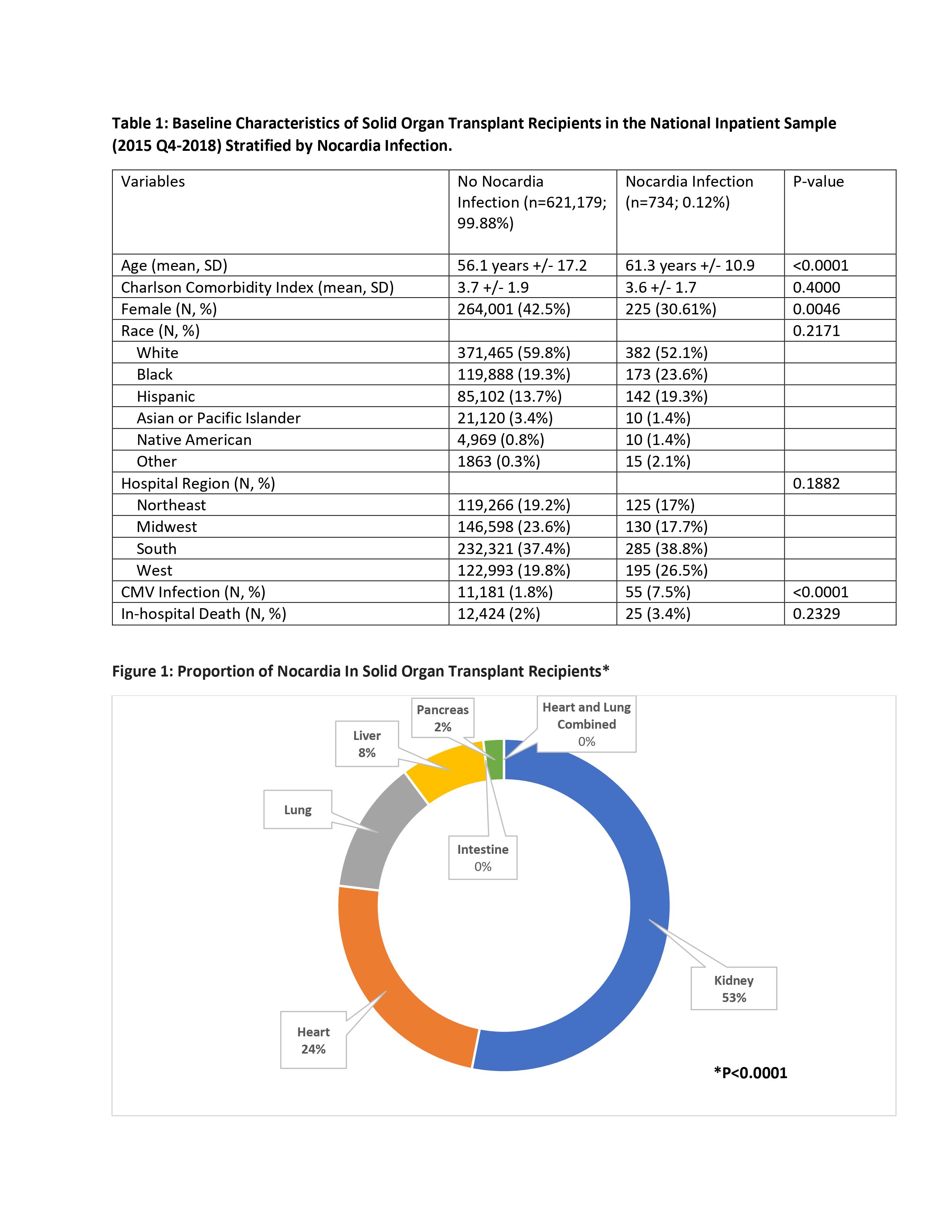Nocardia Infection and Associated Outcomes in Patients with Solid Organ Transplant
R. Munshi1, J. Pellegrini Jr.1, M. Lannom1, N. Nehru2, W. Olsthoorn2, F. Anjum3
1Internal Medicine, Nassau University Medical Center, West Hempstead, NY, 2American University of the Caribbean, Cupecoy, Saint Martin, 3Pulmonary and Critical Care, University of Pennsylvania, Philadelphia, PA
Meeting: 2022 American Transplant Congress
Abstract number: 352
Keywords: Bacterial infection, Outcome
Topic: Clinical Science » Infection Disease » 24 - All Infections (Excluding Kidney & Viral Hepatitis)
Session Information
Session Name: Transplant Infectious Diseases: All Organs
Session Type: Rapid Fire Oral Abstract
Date: Monday, June 6, 2022
Session Time: 5:30pm-7:00pm
 Presentation Time: 5:40pm-5:50pm
Presentation Time: 5:40pm-5:50pm
Location: Hynes Ballroom B
*Purpose: Solid organ transplant (SOT) recipients face various challenges including increased risk of infections. Nocardia is a known pathogen for infecting immunosuppressed individuals, however, there is a paucity in literature on the outcomes of SOT and NI. We sought to evaluate the outcomes associated with nocardiosis in solid organ transplant recipients
*Methods: The study sample was obtained from the National Inpatient Sample (NIS) 2015 quarter 4 through 2018. ICD-10 codes were used to identify patients with nocardia infection (NI) and SOT such as heart, lung, kidney, liver, pancreas, and intestine. Numbers represented in this study were weighted using an algorithm provided by the NIS which allows for accurate national estimates. Variables controlled for in the multivariate regression analysis included age, gender, race, Charlson Comorbidity Index, median income based on zip code, type of insurance, and CMV co-infection.
*Results: A total of 621,925 patients were identified to have SOT, among which 734 (0.12%) patients had NI. Patients with SOT and NI were older compared to the non-NI cohort (61.3 +/- 10.9 vs. 56.1 +/- 17.2; p<0.001); however, both SOT with and without NI were majority white [Table 1]. The highest incidence of NI in SOT patients in the US occurred in the South (38.8%), followed by West (26.5%), Midwest (17.7 %), and Northeast (17.0%) [Table 1]. There were no major differences in baseline CCI between the two cohorts (3.62 vs. 3.73; p=0.40) [Table 1]. Patients with SOT and NI had longer LOS [adjusted mean difference (aMD) 5.7 days] and higher hospital charges adjusted for inflation over time (aMD $66,348); all p<0.01. Moreover, patients with SOT had higher odds of developing NI compared to patients without SOT [adjusted odds ratio (aOR) 13.1; 95% CI 10.0-17.1; p<0.001]. NI was most prevalent in renal transplant (53.1%), followed by heart transplant (23.8%), lung transplant (12.9%), liver transplant (8.2%), and pancreas transplant (2%) recipients (p<0.001) [Figure 1].
*Conclusions: Nocardia is a notorious pathogen known to primarily affect immunocompromised patients. Our study indicates that patients with SOT have a higher odd of developing NI, which translates into longer LOS and higher hospital charges in such patients. Prompt identification with appropriate treatment can help lessen the burden frequently faced by SOT recipients.
To cite this abstract in AMA style:
Munshi R, Jr JPellegrini, Lannom M, Nehru N, Olsthoorn W, Anjum F. Nocardia Infection and Associated Outcomes in Patients with Solid Organ Transplant [abstract]. Am J Transplant. 2022; 22 (suppl 3). https://atcmeetingabstracts.com/abstract/nocardia-infection-and-associated-outcomes-in-patients-with-solid-organ-transplant/. Accessed December 19, 2025.« Back to 2022 American Transplant Congress

